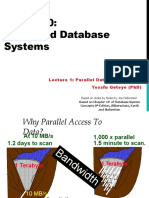0% found this document useful (0 votes)
31 views2 pagesParallel Database QA Detailed
Parallel database systems are crucial for cost-effective hardware utilization, handling large-scale data, speeding up complex queries, supporting multiple users, and ensuring scalability. Partitioning techniques like round-robin, hash, and range help optimize data distribution, while skew management addresses uneven data loads. Both interquery and intraquery parallelism enhance performance by processing multiple queries or breaking down single queries into sub-tasks.
Uploaded by
PRATAP GAMINGCopyright
© © All Rights Reserved
We take content rights seriously. If you suspect this is your content, claim it here.
Available Formats
Download as PDF, TXT or read online on Scribd
0% found this document useful (0 votes)
31 views2 pagesParallel Database QA Detailed
Parallel database systems are crucial for cost-effective hardware utilization, handling large-scale data, speeding up complex queries, supporting multiple users, and ensuring scalability. Partitioning techniques like round-robin, hash, and range help optimize data distribution, while skew management addresses uneven data loads. Both interquery and intraquery parallelism enhance performance by processing multiple queries or breaking down single queries into sub-tasks.
Uploaded by
PRATAP GAMINGCopyright
© © All Rights Reserved
We take content rights seriously. If you suspect this is your content, claim it here.
Available Formats
Download as PDF, TXT or read online on Scribd
/ 2































































































